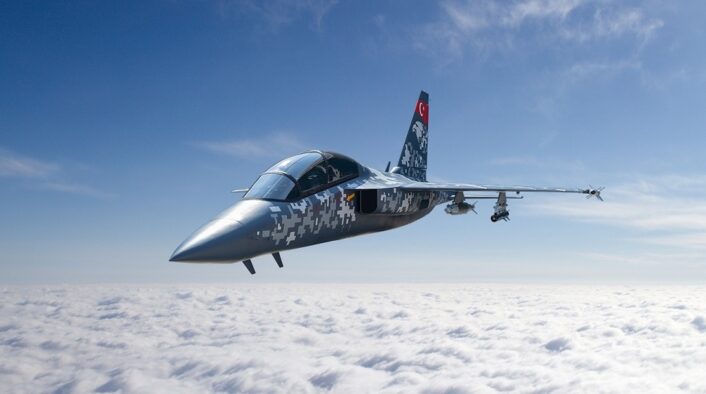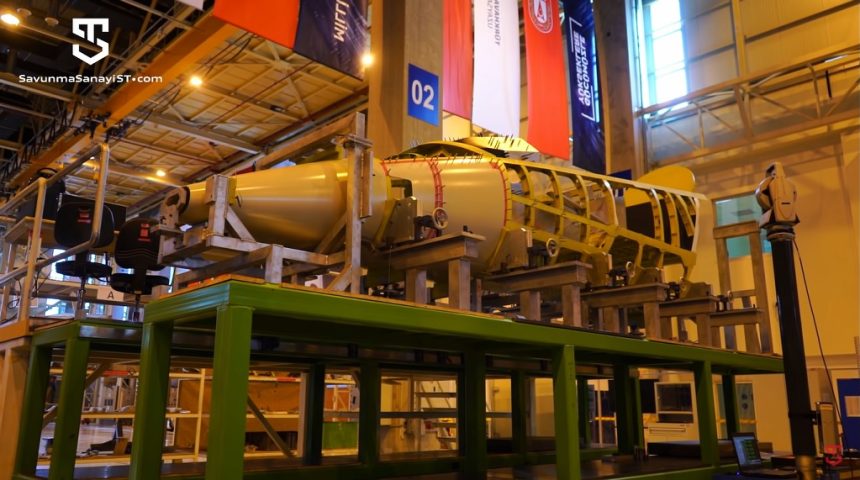The TAI Hürjet is scheduled to fly for the first time in 2023 and will replace the ageing T-38 and F-5 jets.
Over the last decade, Turkey has put great attention on its national aerospace industry, starting many ambitious programs for different types of aircraft, including unmanned ones. One of these programs is the Hürjet, an advanced jet training and light attack aircraft launched in 2017 and developed with the Turkish Aerospace Industries’ (TAI) own resources and the first completely developed in Turkey. Now, the Hürjet prototype entered the assembly phase, with videos showing the front section of the fuselage in the works at TAI’s facilities.
The company is planning the rollout of this first prototype by the end of the year, followed by the first flight on Mar. 18, 2023, coinciding with celebrations for the 108th anniversary of the Çanakkale Naval Victory (WWI Gallipoli campaign). Current plans involve the construction of two flying prototypes, as well as other two for ground static and fatigue testing. According to the images shared online, at least two fuselages are currently in the works.
As the mockup and promotional material show, Hürjet is a single engine, single tail, tandem-seat aircraft. The structure of the two engine air inlets, on the sides of the fuselage, goes all the way to the tail, acting also as main landing gear housing and horizontal tail planes support. Six weapon stations are visible, including the two wingtip rails, to allow the use as light fighter aircraft. The mockup was shown with different types of smart bombs, air-to-air and air-to-ground missiles and external fuel tanks.
The design is not final however, as there are two variants to accommodate two different engines, the General Electric F404-GE-102 and the Eurojet EJ200. The EJ200-powered variant required revised air inlets with an enlarged section and required further wind tunnel testing. At the time of the Critical Design Review last year, the final engine was still unknown and both options were evaluated. According to some sources, the engine that will power the prototype should be the F404.
A possible confirmation of the F404 engine comes from the aircraft specifications, which show a thrust of 17,600 lb. The aircraft has about the same size of other comparable trainers, with a length of 13.6 meters and a wingspan of 9.5 meters. TAI reports a service ceiling of 45,000 ft, max speed of Mach 1.4, range of 1200 nm, and load factors between +8G and -3G, with sustained turns of 5.5G at 15,000 ft and less than Mach 0.9. Other unconfirmed data are a stall speed of 102 KCAS and takeoff distance of about 1000 ft.
Among the jet’s features, the company mentions carefree handling with high AoA (angle of attack) controllability, a full authority, Digital Fly-by-Wire Flight Control System, aerial refueling capability, Auxiliary Power Unit (APU) for autonomous operations, full glass cockpit with Head-up Display (HUD), Helmet Mounted Display (HMD), State-of-the-art HMI (Human-Machine Interface), NVIS (Night Vision Imaging System) compatibility, datalinks and Embedded Tactical Training & Live Virtual Constructive Training systems.

The jet is being developed for multiple roles, Including Advanced Jet Trainer, Lead-In Fighter Trainer, Adversary Aircraft (Aggressor), Aerobatic Demonstration Aircraft, Light Attack and Air Policing. Interestingly, Turkey’s Head of Defence Industry Presidency, Prof. Ismail Demir, stated that there are plans in the works to adapt the Hürjet as an aircraft carrier-compatible aircraft to be deployed on the Turkish Navy’s Landing Helicopter Dock (LHD) Anadolu.
Even if the main focus of the program is to replace the aging 68 T-38Ms Advanced Jet Trainers and 12 NF-5s of the Turkish Stars Aerobatic Team, Turkey is wishing to use the Hürkus also to lessen the burden off the F-16 Fighting Falcon fleet for the Close Air Support missions. Also, TAI is looking at the export market for both the trainer and light fighter aircraft roles as a potential alternative to other aircraft like the Leonardo M-346 or the KAI/Lockheed Martin T-50. An offer for 18 aircraft in a light fighter role has already been submitted to Malaysia.
The plans appear to be pretty ambitious but we need to wait for the “final product” to be available to assess its full potential. In fact, while having significant experience in various fields, including the design, development and production of a wide array of pretty successful drones as well as in the licensed production of various types, including the F-16 Fighting Falcon jets and the CASA/IPTN CN-235 light transport/maritime patrol/surveillance aircraft, a fully indigenous advanced jet trainer design (or a modern generation fighter) may represent a completely different endeavour.
Anyway, TAI is undergoing a rapid expansion, with new facilities inaugurated few days ago to support a multitude of needs, like the Composite Production Building, Space Systems Engineering Center, Factory-Level Component Maintenance and Control Center, and an Engineering Center dedicated to the National Combat Aircraft, the TF-X.
The TF-X, an indigenous 5th gen design, is being designed to replace the F-16 in the 2030s. The first mockup, highly reminiscent of the F-22 Raptor and F-35 Lightning II of the aircraft was unveiled in 2019, while the roll-out is scheduled for 2023 and the first flight by 2025. Not much is known, other than an expected top speed of Mach 1.8, service ceiling of 55,000 ft and 58,000 lb of thrust provided by two F110 engines. According to rumors, the aircraft might even feature a mix of Turkish, Russian and US tech.
Another indigenous program that is already in an advanced status is the Hürkuş, a turboprop trainer developed from the KAI KT-1 designed to replace the T-37 Tweet. The aircraft flew for the first time in 2013, entering service a year later to become the Turkish Air Force’s primary basic training aircraft. Hürkuş is enjoying some export success too, with an order from Niger and strong interest by Azerbaijan.
TAI has heavily invested also in the helicopter sector, developing the T625 Gökbey utility helicopter. The first prototype flew in 2018 and recently a fourth prototype has been unveiled. The helicopter is intended to be used for a wide range of missions and scenarios, for both civilian and military markets, with a MTOW of 6 tonnes and space for up to 12 passengers. Serial production and deliveries are scheduled to start this year, with the first helicopters going to the Gendarmerie.
Last but not least is one of the most known Turkish programs, the T129 ATAK. The attack helicopter, developed from the Italian-made Leonardo AW129 Mangusta with Turkish avionics, weapons and airframe modifications, was a response to the requirement for a new tactical reconnaissance and attack helicopter for the Turkish armed forces. The helicopter, which is now completely different from the Mangusta, is now in widespread service in the Turkish Army and Gendarmerie, with orders also from Philippines and Pakistan.
H/T to @captzulu737 for the heads-up!









